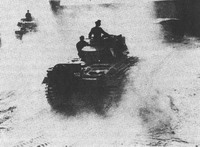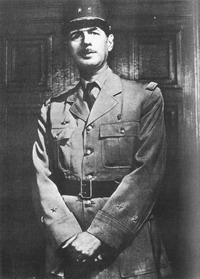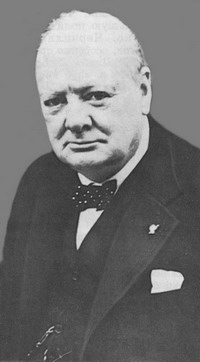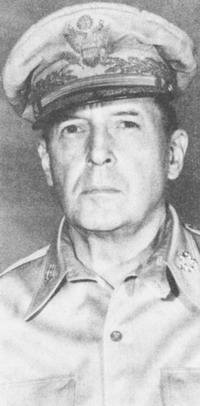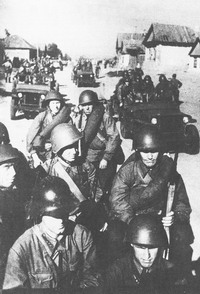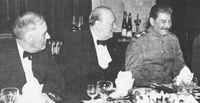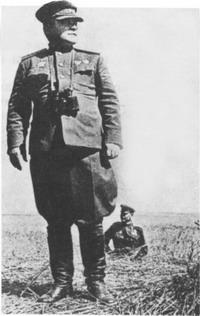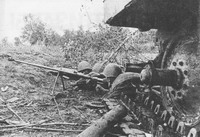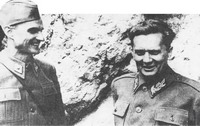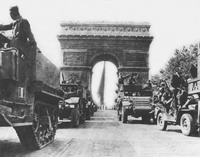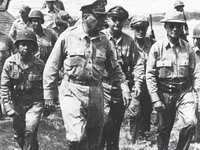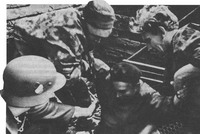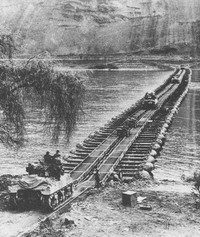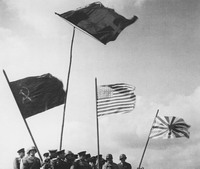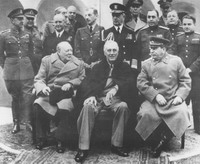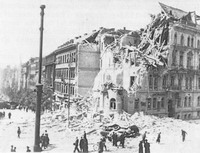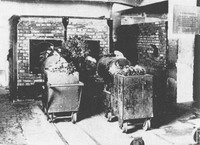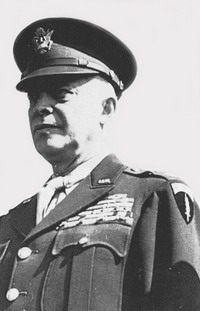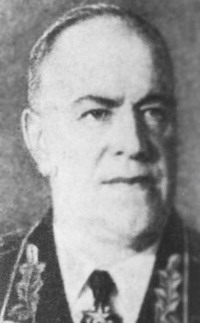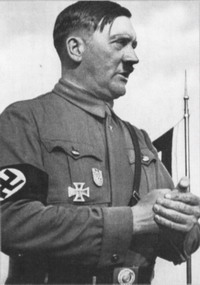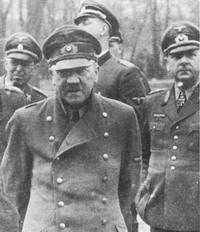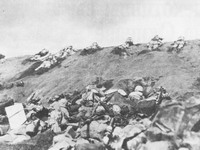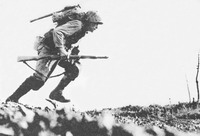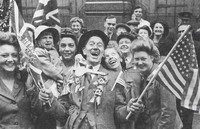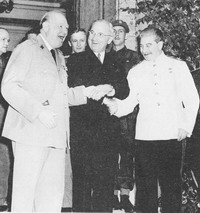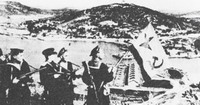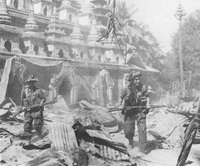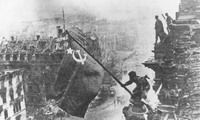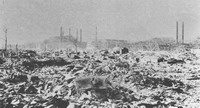§6. Military actions in 1944

1. Offensiveoperations of Soviet troops, liberation of the USSR. Transfer of hostilitiesEastern Europe
With the1944 before Soviet troops were following tasks:
1. Complete release of the USSR he Nazis and their allies.
2. Assist the people of Eastern Europe in ruining Nazi bondage.
3. Output from the war allies Germany.
4. Move the fighting into the territory of the Third Reich.
5. Coordination with the Allied troops who had opened the second front.
Until 1944 troopsNazi Germany and its allies still retained much ofoccupied territories. The allies were fighting in South Italy. Germany was ableexpand production of arms to total mobilization, but strategicinitsiatyvu hitlerivski generals have already lost. Their decisions have disappearedsharpness, correct assessment of the situation. Conversely, a number of operations of the Soviet commandfinal phase of the war became a model in the history of martial arts. Notattempts of large-scale offensive on all fronts, and consistently heldoperations in different areas. Moving blows from one direction to anotherforced the German command forces overrun in one placeSoviet-nimetskoho front to another, latayuchy hole in the defense.
The war put forward many energetic,talented Soviet commanders, who were not afraid to make independentdecision: G. Zhukov, I. Konev, F. Tolbukhina, A. Wasilewski, R. Malinowski,L. Govorov, K. Rokosovskogo, A. Eremenko, K. Meretskov, I. Baghramyan et al.
The hatred grew zaharbnykivthe liberation of towns and villages, when Soviet soldiers saw the traces of destructionviolence and atrocities that they did hitlerivtsi over local populations.
1944 started under attackLeninhradom. January 14 - February 29, 1944 here was carried out successfullyoffensive. The town was completely deblokovano. Ended 900-dayblockade of the legendary city that has lost at least 800 thousand of its inhabitants.
Almost simultaneouslyThis operation developed by the liberation of right bank Ukraine. The key to them wasKorsun-Shevchenko. Army 1 st Ukrainian Front (commander -M. Vatutin) and 2 of the First Ukrainian Front (commander - Ivan Konev)Korsun-Shevchenko surrounded the enemy group. The result has been destroyed55 thousand enemy soldiers? 18 thousand captured. According to military tactics andart environment and the destruction of German groups in the Korsun-Shevchenkowas named "second Stalingrad".
March 26, 1944 Connection 2-UkrainianFront first came to the border of the USSR.
In mid-April war 1Ukrainian front approached the foothills of the Carpathians' I. Most of the Right BankUkraine was liberated.
During the offensive on the Right Bank UkraineApril 8 began operation Crimean 4 th Ukrainian Front (commander -F. Tolbukhina). It ended May 12, 1944 utter defeatGerman-fascist groups and liberation of Crimea. DespiteFierce resistance to the enemy, May 9, 1944 Sevastopol was released. In thesefighting the enemy lost 100 thousand killed and wounded, and a lot offighting vehicles.
Nimetske command believed thatsummer 1944 Soviet army offensive continues southwards.
However, since spring 1944 waspreparing summer offensive by the defeat of Army Group Centre,Bilorussiyi release, Baltic States, Western Ukraine. To this end,prepared a series of operations, the key of which had become "Bagration".
Overall balance of power on
Soviet-German front in summer 1944
|
|
Personnel
|
Tanks
|
Guns
|
Aircraft
|
|
Soviet troops
|
6.5 million people.
|
8000
|
83200
|
11800
|
|
German troops and their allies
|
4 million people.
|
5200
|
49000
|
2800
|
Summer offensive of Soviet troopsbegan June 10, 1944 Deposition of a powerful blow to the Finnish Armyon the Karelian isthmus. September 2, 1944 Government of Finland has signedarmistice with the USSR. The Soviet Union left in a territory which was annexed byhim in 1940 In October 1944, in accordance with the consent of the NorwegianGovernment of the Soviet army entered the territory of Norway, it liberated the northernpart.
The main impact of Soviet troopssummer was aimed at Belarus. Configuration requires a frontoperation was a tremendous performance. Most protected in the Naziwere flank. It is for them and planned at the powerful blows. The area with its rivers,lakes, swamps, forests was convenient for those who have defended, and, conversely, creatingbig problems for those advancing. For three years, the Nazis turned the cityBelarus in the strong fortified area. The fact that in 1941 it was so suddenabandoned, now, summer 1944, had to beat, relying oncourage and heroism of Soviet soldiers samoviddanist.
This operation under the code-Belaruscalled Bahration "began June 23 and continued until August 29, 1944 TimThe Soviet Union performed the same commitment to a great deal simultaneously withopening a second front. The attack was carried out in Belarus by fourfronts under the overall command of G. Zhukov (1,2 million.,4 thousand Tank, 24 thousand guns, planes 5,4 thousand). With data on weakDefense party opponent (the Soviet troops resisted 850 thousand people. 42Division), Zhukov decided pominyaty previously determined roll. Smilyvymblow Tank Corps managed to capture the river crossing and Berezinabout 10 divisions nimetsko Nazi troops found themselves surrounded by (about100 thousand).
Mature, long-term systemenemy's defense turned in "pots" - Bobruisk, Minsk,Mogilev, Vitebsk. July 3 was released Minsk, more precisely - its ruins.Front prorvano was over 400 km.
Soviet troops came to the borders of East Prussia and Poland. OnlyThrough a series of thoughtful powerful retaliation of the German armorCommand could not avoid the final defeat.
I wonder
During the Belarusianoperations July 17, 1944 about 60 thousand prisoners in Nazi guardSoviet soldiers passed the streets of Moscow. Following their voices machines thatwashed asphalt, symbolizing the cleansing of this homeland from Naziinvaders.
Building on the success forces in Belarus1 st Ukrainian Front (Marshal Ivan Konev, commander) successfully conductedLvov-Sandomierz Offensive (13 July - 29 August 1944). UnderBrody was broken eight German divisions numbering about 60 thousand people. ThusSoviet army was rapidly eastern Galicia, occupying Lvov, Przemysl and Stanislaw.Relieved of Belarus and western Ukraine, July 29, our troops Soviettroops came to the Vistula, took the suburbs of Warsaw Prague, and began to move herforcing. Bilshist those who crossed in the front ranks, killed, butfoothold on the West River berezi was withheld.
Simultaneously with the attack in BelarusSoviet troops conducted an operation to release the Baltic States. Prybaltiyskeenemy group, which counted more than 30 divisions after a successfulthe Soviet troops were trapped on nevelykiy in Latvia, wherething in captivity in May 1945
In late summer in the centralpart of the Soviet-German front the situation has stabilized before1945: Soviet army liberated Belarus, Eastern Galicia, part ofLithuania and Latvia, came to the borders of East Prussia, and forsuvala River NarewVistula.
After capturing the Soviettroops Drogobychsko-Borislavskoe oilfields only sourceoil for the German army remained oil fields in Romania. Therefore, theyDefence for the German command had priority. Grouping"Southern Ukraine was one of the most powerful in the Wehrmacht. To defeat thisgroup developed the Soviet command Iasi-Kishinev operation (20-29August 1944). As a result, its holding was surrounded and defeatedmain forces of Army Group "South Ukraine, Moldavia released. The success of the operationforced Romania to seek after peace and Finland out of war.
In October 1944, as a resultCarpathian-Uzhgorod operation was completely liberated territory of Ukraine.
By mid-fall 1944Soviet border was restored to almost its entire length.
I wonder
Liberation of the USSRaccompanied by massive repression of the Stalinist regime against the peoples to whichrelying wine in collaboration with the enemy. Back in August 1941 waseliminated autonomous region Volga Germans were deported 370 thousand people.Top 50's German special settlers there were 1.2 million people.
In 1943-1944 he as reportedBeria to Stalin "as a result of three operations displaced in eastern parts of the USSR 650thousand Chechens, Ingush, Kalmyk, karachayevtsiv. Subsequently, another 40 thousand Balkars.
In 1944 were evicted from the Crimea200 thousand Tatars. Greeks, Bulgarians, Armenians. From Georgia - nearly 90 thousandTurk-Meskhetians, Kurds and others.
On the road to follow fordeportation to Siberia and Kazakhstan died: half of the Chechens, Ingush, Kalmyk,Balkars, third karachayevtsiv.
Total Top 50'sspecial settlers of different nationalities, there were 2,8 million
As Nikita Khrushchev claimed in its reportat the XX congress of the CPSU, Stalin cherished plans eviction of all Ukrainian, but theirproved too much. However, western regions of Ukraine in 40-50-yearsdeported 10% of the population.
The liberation of Soviet territory was accompanied byin some areas of the release of Soviet troops in neighboring countries -Poland, Romania, Hungary and Czechoslovakia. It created a fundamentally differentsituation. At the end of 1944 Soviet army, which numbered 6.5 million people.resisted the German army and its allies numbering two million people. (190 thousand people.- Allies).
In September 1944 Under Stalina conversation with Yugoslav partisan Gen. Milovan Dzhylasomexpressed as follows: "This war is different from past wars: the one whocaptures the territory seized by force can the country take their socialsystem. Each if its army is capable of it, may imposed jazaty your own. In another words, thiswould not have been possible. "
2. OpeningSecond Front. Liberation of France
Stalin demanded as soon as possible allies inbegin hostilities against Nazi troops in western Europe. United isallied command out of the need for careful preparation before the openingSecond Front.
I wonder
The first attempt to explore the possibilityD-Europe, a sort of battle reconnaissance was carried outlimited command of English by the British, American,Canadian and French soldiers August 19, 1942 in the smallHarbor Place Dieppe. Paratroopers were dropped into the sea. Failure showed thatlanding in northern France requires preparation, but she had a protractedcharacter.
After the Quebec Conferenceleaders in the U.S. and England in April 1943 begins the process of developingdetailed plan of landing troops allied to mainland Europe.Anglo-American conference in Cairo on December 5, 1943 determined thatmost important operations in 1944 have to be invasion of northern FranceNormandy ("Overlord") and the south of France (Envil). Supreme HeadquartersAllied expeditionary forces led by Eisenhower, and development transactions entered intofinal phase. The new plan developed by the commander of the ArmyAllied troops in Europe, Montgomery and Eisenhower approved, five uniondivisions were to seize bridgeheads near Peninsula Kotanten to furtherprogress in the region Cherbourg and Le Havre port.
There were two main directions: eastin the Ruhr area and south to join forces with troops who hadto land on the Mediterranean coast of France.
Intentions allies opposed the planGerman command, which involved the protection "Atlantic shaft" -defensive installations along the coast of France. Approaches to its implementationwere different. Commanding all troops in the west Rundshtedt out of ordervysadyatsya's allies in the narrowest place of the English Channel - between Calais and Dieppe, asshould give them an opportunity to disembark and then crush them and dropremaining troops into the sea.
By contrast Romel believed thatlanding in Normandy and will not want to allow the allies to land.
German defense system"Atlantic Val prostyaalasya from Antwerp to the Bay of Biscay and furtherall the French Mediterranean coast (more than 2 km.). Against itAllies concentrated powerful invading forces: 45 divisions (1 million people.) fittedall necessary, were supported 15 thousand 1 thousand aircraft and ships.
The German group aroundlanding numbered 526 thousand soldiers, two thousand tanks, guns and 6,7 thousandmortars, 160 combat capable aircraft.
At dawn JuneJune 1944 (Day "D"), despite the difficult situation on the stormsea, began landing Allied troops in Normandy. In the first wave vysadzhuvalosya200 thousand Allied group. It was open second front inEurope.
Although the allies securedhuge advantage in air and demoralized Germans devastating bombingthey failed to execute the plan the first day. Their losses amounted to nearly 5 thousandpeople. Particularly affected Airborne parts.
Soon allies and developed a successfulpurified from the Germans Kotanten peninsula, captured the strategically important portsCherbourg and Cannes.
I wonder
On the night of 12 on 13 June for the first time nimtsirockets used against England FA-1. This was the "miracle weapons" that Hitlerplaced special hopes. But the effectiveness of bombing the English coast,London and other cities in Europe
doodlebug was too weak (in general was released 5097FA-1).
On October 13, 1944 Germanybegan to use another kind of "wonder-weapons - ballistic missiles FAU-2.Overall it was released in England, France, Belgium 994. From shock FA-1, -2killed over 3 thousand people. and 5 thousand wounded These new weapons designs did not changeand could not reverse the course of the war to Germany.
The Allies finally interceptedinitiative, when General Montgomery managed to defeat German tanks andmechanical parts in the Falez-Arzhantan.
The plan "Envil" on landingin southern France for the liberation of the country's allies long postponed. OnlyAugust 15, 1944 air and sea landing landed in the areaSaint Tropeza and Cannes.
In the rear of the German troops werethousands of units of guerrillas. After the French Division surrounded ToulonMarseille and from land and fleet blocked out to sea, nimetski harnizony capitulated.French troops went to chase the American, who moved in the direction of Lyon.Relieved of Dijon, the French are united with the American Army. The attack in southernwas the most successful operation. Allies minimal losses (1300 people) to piecesdefeated the German group (captive was taken 47 thousand soldiers of the enemy).
I wonder
The final phase of war in Europecharacterized by extraordinary politicization of action as union leaders in the Westand Soviet leaders in the east. Campaign in the Balkans hadmilitary-strategic importance, but opposition to plans of Churchill, Stalinsought to provide itself the political advantages in the post-war settlementEurope. In turn, Churchill also dreamed that the allies firstwere in Vienna and Berlin, and thus decided the fate of Germany and the countriesDanube basin.
Finally, Stalin and Churchill in autumn1944 the talks in Moscow have reached agreement on the distribution areasinfluence in Eastern Europe.
As written by Churchill in his memoirs:"Created a business atmosphere, and I said:" Let us settle our affairs inBalkans. Your armies are in Romania and Bulgaria. We have interests there,mission agents. Let us not quarrel over this nonsense. As for England andRussia. Do you agree that we may have a prevailing influence of 90% in Greece andin half - in Yugoslavia. " While it perekladalosya I took half a sheet of paperand wrote:
Romania: Russia -90%, others - 10%.
Greece: Great Britain (in accord with the United States) - 90%, Russia - 10%.
Yugoslavia: 50 to 50%
Hungary: 50 to 50%.
Bulgaria: Russia - 75%, other - 25%.
I handed this sheet to Stalin, whohad already heard the translation. There was a small pause. He then took the bluepencil and putting a great jackdaws, returned it to me? "
Leaf while lying on the table,Churchill offered his early burn. "Does not seem too cynicalthat we have investigated these issues, important for millions of people, sobeztsaremonno? "- Churchill asked Stalin. "No - he responded. - You can takehim.
Political competition and characterizedof France, where despite the ambitions of Churchill? grew authoritative politicalfigure of Charles de Gaulle.
Especially, these differences wereduring the development and operation of the liberation of Paris. Eisenhowernot originally planned to lead the battle for Paris, sought to bypass it. Since Parisfor the French was a symbol of national greatness, spiritual center of the country andfocus of its communications, they wanted to release his own strength.
In August, began a strike in Parisrailwaymen, and in the following days and guerrillas captured pidpilnyky goalsQuarters. Paris Liberation Committee ordered the armeduprising.
When de Gaulle received news ofEvents in Paris, he immediately appealed to Eisenhower to send the request todyviziyu French aid insurgents. First, the commander left this requirementtemporary French President disregarded. But de Gaulle had made his.
Tanks French division ofbloody battles went to Paris. In support of them cameU.S. Infantry Division. Remains of German harnizonu capitulated. WhereGaulle ordered parts of the General F. Leklerka hold a parade onElysian fields. France saluted fighters of the Resistance movement, he recognizedhead of de Gaulle and General Leklerka troops.

Second FreeFrench Armored Division passes by
Arc de Triomphe during vyzvolennnya Paris.1944
After the liberation of Paris begancomplete expulsion of Germans from French territory and exit allied armies to the bordersReich.
When the Allies liberation of Francelost 40 thousand dead and 165 thousand injured, 20 thousand propavshyh missing. Germanlosses amounted to 700 thousand people. (Killed, wounded, prisoners, etc.) butGerman command kept discipline management system remainedand high morale army. German troops went to the borders of the Reich.
British Field Marshal Montgomery andU.S. Lieutenant General Bradley believed that the attacks committed by the Germantroops in France, has created favorable conditions for the defeat of Germany. Theydeveloped a bold plan to seize bridges in the lower reaches of the Rhine and r.Maasu thatlittle to open the way to bypass parts of the armor "Siegfried Line" from the north andReleased on their operational space. A key role in the operation had to playAirborne part. This plan was approved by the allied command asOperation Market-Garden "(" City "). In the history of this operation is entered under the nameArnemska Airborne Operation (17-26 September 1944). A coincidencecircumstances (weather conditions, the election failed invasion, unexpectedconcentration of German SS tank units in the region, etc.) and strong resistanceGerman military operations did not succeed. But courage, demonstratedEnglish fighters on the 1 st Airborne Division, became the heroic pagesEnglish army.
However, this operation created the conditionsfor the liberation of a large port city of Antwerp in Belgium, which becamemain to supply the Allied armed forces.
3. LiberationEastern Europe
In 1944 millions of Sovietsoldatskiy people in the form of crossed Soviet Union. Their firstsee other countries, another way of life. They honestly and courageously fought, died onchuzhiy land, knowing that without the final defeat of Germany and its hitlerivskoyiallies will not be peace in the world.
July 20, 1944 troopsRed Army entered the territory of Poland. The next day was publishedmanifesto of the Polish Committee of National Liberation (PKNV), which wasformed with pro-Soviet-minded activists. A few days later the SovietGovernment recognized the Committee's right to establish national bodies of the Polishadministratsiyi delivered to the territory. Heads of Polish emigreGovernment in England believed that the future government of the country they should not belongless than 80% of the seats. The Soviet government pidtrymuvav PKNV in its disagreement with theseexpectations.
Seeking to avoid losing its influence inliberated Poland emihranskyy government and its militias (National Army)Soviet leadership sought to put before the fact of restoration of Polishadministration. August 1, 1944 forces acting on the instructions of the PolishGovernment in London, raised anti-fascist uprising in Warsaw. He supportedmost residents. Managers of the uprising (T.Bur-Komorowski, etc.).sought to consolidate in Warsaw for entry of Soviet troops there. However, the plan does notsucceeded. Stalin called the leaders of the rebellion adventurers and criminals. Soviettroops came to help, and German troops with him in cold bloodcrack, turning the city into ruins. Over 93 days of battles killed 18 thousandrebels and 25 thousand were wounded. Killed 150 thousand civilians.German losses were respectively 17 and 9 thousand people and 200 tanks.The participants of the uprising were detained, expelled the population and the city was undermined. How toJanuary 1945 Red army knocked Nazis in Warsaw. Thus withthe entry of Soviet troops in Eastern Europe in its actions were clearlyproslidkovuvatysya political reasons.
With the liberation of Poland, died 600thousands of Soviet soldiers. Successfully develop Iasi-Kishinev operation gaveable to transfer boyovi action on the Romanian territory.
The Soviet government made a statementin which noted that the USSR does not seek to acquire any part of the Romanianterritory, or to change the existing system in Romania and aims at together with Romaniansrestore the independence of the country and liberate it from Nazi troops. Inif the Romanian troops cease hostilities against the Soviet army andundertake jointly with the Soviet Army to conduct a war of liberation againstNazi Germany, Red Army not rozzbroyuvatyme them, keep themcompletely all weapons and all means to help accomplish this honorable task. "
Patriotic warRomania led by the King and Micah boyovi troops who supported them,liberated the capital - Bucharest and held the city for the Soviet approachtroops. Earlier, together with the Soviet army led offensive is formed onRomanian territory of the USSR Voluntary dyviziya them. Vladimirescu Tudor, thenow in the liberation of the country took part and other parts of Romania.After the overthrow of the dictatorship of General Antonescu, the country announced to join theanti-Hitler coalition. Already in August 1944 Romania's territory wasliberated.
Liberating the territory of Romania,units 3-st Ukrainian Front came to Romania-Bulgarian border.The Bulgarian government has in 1941 joined the Anti-Comintern Pactdeclared war on U.S. and UK, but did not dare do the same forSoviet Union. At the end of July 1944 Bulgarian government entered intosekretni contacts with the Anglo-American officials in Cairo, askingthe question of sending the Anglo-American troops in Bulgaria. September 5The Soviet government made a statement: because Bulgaria was at war with theAnti-Hitler coalition, and the Soviet Union from now considers itself in a statewar with Bulgaria. Talks in Cairo were suspended.
Urantsi September 8 of the Sovietwere ready to open the fire. However, when the Soviet Army garrisoncrossed the Bulgarian border, one of the Bulgarian Army infantry divisions metPart of deployed Soviet flags and festive music. Because ofSeptember 1944 armed insurrection patriotic forces of Bulgaria and ActionSoviet Army monarch-fascist regime in Bulgaria was overthrown.
Bulgarian army and to pour itGuerillas in force in the country, together with Soviettroops dislodged the scattered groups of German units that were in Bulgaria,and came to the Bulgarian-Yugoslav border.
Each of the countries in which liberationparticipated in the Soviet Army, vidznachalasya svoyeridnistyu political situation.For Yugoslavia was characterized by extensive development of mass armed struggle againstHitler's invaders and their henchman. People's Liberation ArmyYugoslavia consisted of about 400 thousand biytsiv. Allies vsilyakohelped the fascist forces of Yugoslavia.
At the end of September 1944 wasjoint action plan developed parts 3 of the First Ukrainian Front and the subdivisionNVAYU.
During the assault on the capital of YugoslaviaBelgrade Front Command has fulfilled the request of the Yugoslavs: their parts includedto the cities first. After the liberation of Belgrade received an order to consolidate and Ponds"Further inland Yugoslavia not move." Yuhoslavski completely cleared ofits own territory.
`I Conclusion truce with the AlliesGermany
|
Date
|
Country
|
|
September 12, 1944
|
Romania
|
|
September 19, 1944
|
Finland
|
|
October 28, 1944
|
Bulgaria
|
|
January 20, 1945
|
Hungary
|
Vazhki trials endured bybiytsiv 2-Ukrainian Front, which entered the territory of Hungary.
The Hungarian Government headed by a dictatorHorthy, in conditions approaching the front trying to find understanding with the countriesAnti-Hitler coalition. Negotiations on withdrawal of Hungary from the war weresuccessful. But when it became known German command, it,vypyredyvshy Allied troops, occupied Hungary, Horthy was arrested, andits place put the leader of Hungarian fascists Szalasi. As a result, Hungaryremained the only ally of Germany, which fought to end the war. TroopsWehrmacht actively supported by the Hungarian army did fierce resistance. Anotherunits 2-st Ukrainian Front had, as in the first year of war experiencebitterness environment. The troops are tired, broke away from the base, were subjected to prolongedbattles heavy losses. Two attempts to master the Budapest failed. It becameclear that one of the front task forces do not succeed. In the second halfNovember, forsuvavshy Danube in Hungary from Yugoslavia joined forces3-rd Ukrainian Front. United front, surrounding the German-Fascistgroups and Hungarian troops in the Budapest area. The fight for the city, notprypynyayuchys any one day, lasted until mid-February 1945, afterWhy not less bloody battle took place near Lake Balaton, where GermanCommand organized the last great offensive against the Soviet army. Onlyin early April battle ended in Hungary. Then the Soviettroops entered Austria in Vienna and was released.
Spring 1944 Red Armygave assistance to the national anti-fascist uprising in Slovakia? although itwas suppressed. Here, in the Carpathians, with Soviet soldiers for theirCzechoslovak troops fought their homeland. It was liberated land SubcarpathianUkraine and some regions of Slovakia. Finally, Czechoslovakia was liberated inMay 1945 Successful offensive of Soviet troops in Eastern Europewere favorable conditions for the release of Albania and Greece, where the guerrilla armydefeated the enemy.
Liberating Mission of the Soviet army inEurope
|
Countries
|
Dates of operation
|
Names of operations
|
|
Romania
|
27 March
October 5, 1944
|
Yasko-Kyshynivs'ka
|
|
Bulgaria
|
8-28 September, the 19 944
|
Yasko-Kyshynivs'ka
|
|
Yugoslavia
|
September 22 -
December 25, 1944
|
Belgrade
|
|
Poland
|
July 17, 1944 -
May 8, 1945
|
Lvov-Sandomierz, Warsaw,
Vistula-Oderska,
Silesian, East Prussian
|
|
Czechoslovakia
|
August 22, 1944 -
May 11, 1945
|
: East, Prague
|
|
Hungary
|
September 23, 1944 -
April 4 1945
|
Budapest
|
|
The northern part of Norway
|
7-29 October 1944
|
Murmansk
|
|
The eastern part of Austria
|
3 March - April 15, 1945
|
Vienna
|
|
East Germany
|
January 12 -
May 9, 1945
|
Shidnoprusska, Berlin
|
4. OffensiveGerman troops in the Ardennes
In October 1944, Allieslaunched an operation whose purpose was to break through the "Siegfried Line" to force the Rhine andmaster Rurom - German industrial base. However offensive the Allies werestopped.
Allied troops who suppliedall necessary U.S. and England were connected to property 'definition of the Atlanticcommunications, which in turn depended on the throughput capacity of portsNorthern France, Belgium and Holland. German troops, retreating, trying todestroy most port facilities, communications. The only large portAllies reached without significant damage was Antwerp. He was aboutto the front and was ideal in terms of supplying military allies.
Hitler, losing on all frontsnot abandon hopes to reverse the course of the war in their favor. Great expectations helaid on the differences between the allies. "I can see how these contradictions areincreasingly stronger with each passing hour. If now we'll cause a fewheavy blows, then this? united front suddenly collapse. "
For this purpose the German commandprepared a large offensive in the west near Arden. The aim of the operation wasenvironment of the Allied forces and capture Antwerp. With 39 against 89 divisionsalliance, the German command concentrated on their relatively narrow areaFront. Of the German offensive that helped that the weather would not allowAllies advantage in aviation. The German plan was realgamble. German tanks had fuel per 100 km. All calculationsbreakthrough front was based on the surprise capture of fuel storageU.S. Army. The successful promotion of German troops was createdunit, disguised in the form of American army led by O. Skortseni. Hehad to move troops tylamy allies spread panic and grabimportant objects.
The German offensive began 16December and lasted until December 26, 1944 The Germans moved 90 km deep into the defenseallies and stood still. Reserves were exhausted, especially fuel. EarlyJanuary German forces launched another attack in Alsace. Situation,in which neither the Allies nor the German troops could not reverse the course of fighting on theirside.
W. Churchill asked Stalin, withto begin the Soviet troops. January 12 Soviet troopsattacked at 1200 kmsector of the front. Also recovered from a stroke and allies who have becomethrow back the German troops. Thus, the last hope to break into HitlerDuring the war was not fulfilled.
Realizing the hopelessnessfurther offensive, German troops were taken to "Siegfried Line", andoperationally the most part been directed at the Soviet-German front in the regionBudapest.
6.
The fighting at the theater tyhokeanskomu

In early 1944 U.S.established control over the Marshall Islands, and over time - overMarianas. In July began the operation to liberate the Philippines, capturewhich would mean for Japan distribution of its holdings into two parts and loss of sourcesraw materials that were south. At the same time, U.S. strategicaviation started the "air attack"against Japan, carrying out systematic bombing of military and economic objectscountry. Under such conditions, the Japanese command decided to give a decisive battle inNear Fr. Leyte (Philippine Islands), defeating American troops andfleet support (plan "Se" (Victory).
October 23, 1944 near the islandLeyte (Philippines) launched the largest in the history of the Second World War Maritimebattle between the allies and the Japanese fleet. In it from both sides participated in 330korabli large, including 39 and 21 avianostsiv linkor. As a result, a 4-dayJapanese battle fleet was destroyed and he ceased to exist asorganized fighting force, suffered a decisive defeat and Japanese aircraft.Japanese losses amounted to 4 avianostsi 3 linkory, 10 cruisers and largenumber of smaller vessels, as well as 500 aircraft. U.S. carriers lost 2, 3destroyers and 200 aircraft.
After this victory the U.S.troops launched a decisive attack on the Philippines and the end of year releasethem. Virtually Japan has already lost the war, but its management was not yet readyadmit it. The war continued, bearing new victims and destruction.
To restore access to sourcesstrategic raw materials in the south of the Japanese command developed and successfullyprovylo offensive in China, capturing the south. As a resultwas laid overland route delivery of raw materials, much of the warproduction was moved to Korea and Manchuria. Opposition to U.S. NavyJapanese began to use mass-suicidal attack "kamikaze". This meantthe final defeat of Japan requires time and tension of all forcesAnti-Hitler coalition. But it was only possible after the warAction in Europe.
Results
1944 was a year of decisivevictories of the anti-Hitler coalition. Nazi troops finally blockStrategic Initiatives lost at the end of the year alone unit actually collapsed.However, tension has been fighting no less than in previous years. Reductionfront line allowed Germany a more rational use of availablehuman and material resources and even cause significant retaliation. However, increasingpower of the Soviet army, its commanders warcraft, openingSecond Front finally buried any hope of Germany at the endWar with favorable consequences for her.
Questions and tasks:
1. As events evolved, the Soviet-German front in 1944?
2. Fill in the table: The main offensive operations of Soviet troops in 1944for the liberation of Soviet territory.
3. When and where to open a second front? What name was of amphibious operationAllied forces in Normandy? As a defensive line known as the German troopsalong the coast of France?
4. How was the liberation of France and Belgium?
5. Which countries were liberated by Soviet troops in 1944?
6. Hungarian writer Sandor Mara, who lived in the house of Soviet soldierswith pain and compassion, wrote: "? this young soldier and offered a kind ofliberation, deliverance from Nazi terror. But freedom does not bring itcould, because it was not himself. " What is your attitude to the liberation mission of the Soviet Armyin Eastern Europe in 1944-1945 he was? Justify your answer.
7. When Germany's allies and who capitulated?
8. What can explain the fierce resistance of German troops in the closing periodwar?
9. Objectives pursued the German command, making the end1944 offensive in the Ardennes? What were its consequences? Why not attack reachedgoal?
10. Where there were anti-fascist uprising in 1944?
11. While conducting combat operations in 1944 anti-Hitler coalition countriesguided primarily military or political considerations?
12. Where American troops won the war in the Pacific1944?
 English
English















